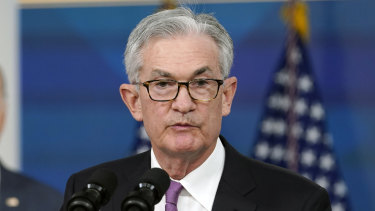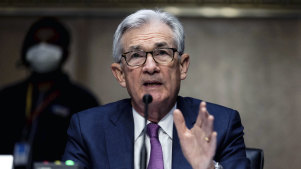OPINION
A fiscal and liquidity cliff is looming as policymakers slam on the brakes
For our free coronavirus pandemic coverage, learn more here.
A year ago governments and central banks were in the midst of near-unprecedented fiscal expansion and stimulus. Now they are in the early stage of quite dramatic policy U-turns. What could possibly go wrong?
The catalyst for the abrupt shifts in policy stances, of course, are the breakouts of inflation.
While last week’s 7 per cent headline rate of inflation in the US has captured most of the attention, inflation rates in the other major economies – the UK, eurozone, Japan and China – have also been rising towards 5 per cent; levels not seen since the global financial crisis.
Because of the outsized role the US plays in global economic and finance, the surge in US inflation to levels not seen for 40 years is of particular significance and concern because it is likely to force the US Federal Reserve to act more decisively and quickly than anyone could have envisaged even a few months ago.
As recently as September last year the consensus at the Fed was that there’d be only one 25 basis point rise in the federal funds rate this year. By December the expectation had swollen to three rate hikes. Now Fed governors and other officials are talking about the prospect of four or more. Some are publicly canvassing the possibility of a 50 basis point rise to start the cycle.
Last year the Fed was anticipating that it would end its quantitative easing – its $US120 billion ($166 billion) a month of bond and mortgage purchases – in the middle of this year and then waiting until the new rate cycle was well established before starting to shrink its balance sheet.
RELATED ARTICLE
It is now contemplating the end of the buying in March and an aggressive winding down of its $US8.8 trillion balance sheet, sucking liquidity out of the US and global financial systems.
To lesser degrees the central banks of the other major developed economies are also considering backing out of their COVID-inspired stimulus programs.
That about-turn in central bank policies, from pumping vast injections of monetary stimulus into their financial systems – over the course of the pandemic the key central banks have pumped more than $US10 trillion of liquidity into the global system – to withdrawing liquidity would represent a quite dramatic tightening of financial conditions.
Macquarie Bank research issued last week estimates more than $US2 trillion of central bank liquidity will be withdrawn over the next 18 months. If inflation rates continue to spike it could well be significantly more.
Governments, which responded to the pandemic with fiscal expansions unprecedented in the post-war era, are now winding back their spending rapidly as pandemic relief programs have been allowed to run off.
Combine the actions of the central banks and governments and you have an enormous, contractionary fiscal and monetary policy cliff. The policymakers are shifting quite abruptly from a “pedal to the metal” response to the pandemic to slamming on the brakes.
The spike in interest rates and far lower liquidity levels in prospect would be occurring in a world awash with debt. Even before the pandemic, global debt levels were high but the fiscal relief packages have swollen them further.
According to the Institute of International Finance, global debt was about $US250 trillion, or 320 per cent of global GDP, in 2018. By the September quarter of last year it was almost $US300 trillion, or 350 per cent of global GDP.
That means the finances of governments, businesses and households are now acutely sensitive to changes in interest rates and the availability of money, and it makes monetary policy decisions more difficult and sensitive than they already were.
If the Fed and its peers miscalculate in either direction – if they misread the outlook for inflation – they could do real damage to economies, businesses and individuals.
Until the pandemic and the supply chain disruptions that occurred even as consumer demand soared in developed economies, central banks were more concerned about the absence of inflation than its threat.
With exquisitely poor timing the Fed last year even changed its long-standing policy framework from trying to pre-empt inflation to, with its “Flexible Average Inflation Target” policy, responding to it after it had overshot the bank’s target rate. A few months later it has been forced to shift from encouraging an increase in inflation to fighting one.
While the extent of the leverage in the US economy makes it improbable that the Fed will be forced to do what Paul Volker did just over 40 years ago and raise US rates to 19 per cent to crush soaring inflation, it is clear that the rate at which inflation has ratcheted up and spread throughout the economy has taken the Fed and most market analysts by surprise and therefore will force it to do more than it or most market participants envisaged.
It is the dawning recognition of the extent to which the Fed is being forced to change tack that has unsettled financial markets that have become addicted to cheap liquidity. It has melted down crypto assets and savaged technology company valuations over the past week or so.
It is the dawning recognition of the extent to which the Fed is being forced to change tack that has unsettled financial markets that have become addicted to cheap liquidity.
Worst-case scenarios – the open discussion among Fed officials of four, five or even six rate rises this year and an accelerated shrinkage of the Fed’s balance sheet – aren’t, however, priced in.
Perhaps investors are still relying on the “Greenspan put,” or a conviction that in times of market turbulence the Fed will always bail them out. For nearly 35 years the Fed has reinforced that conviction in its responses to market “tantrums,” or sell-off of shares and/or spikes in bond yields.




No comments:
Post a Comment